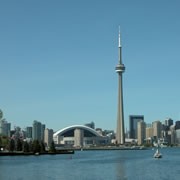When it comes to melting pots, Toronto turns up the heat. Within its limits are vibrant communities like Greektown, Little Portugal, Koreatown, Little India and one of North America's largest Chinatowns. A United Nations agency lists Toronto as second only to Miami as the city with the most foreign-born residents.
"Toronto is the biggest melting pot in the world. It has every type of ethnicity and nationality," says renowned comedian Russell Peters, a Toronto-born Anglo-Indian native who grew up in the Toronto suburb Brampton. "Most of those people manage to hang onto their culture," adds Peters, known for his Comedy Central special Russell Peters: Outsourced and more-recent DVD Russell Peters: Red, White, and Brown.
The city's richness in cultural diversity translates to a vibrant arts and culture scene. Peters himself was a mainstay in the Toronto arts scene for some 20 years before his recent relocation to Los Angeles.
"I started at Yuk Yuk’s in Toronto back in ’89,” he says. “I was never very good at the beginning, but the clubs were always good. In ‘89 and the early ‘90s, the comedy boom had subsided, so it was the best time to learn."
Other Yuk Yuk's alumni include Jim Carrey, Martin Short and John Candy.
Peters also moonlights as a DJ, and has worked the Toronto club scene.
"Toronto is a really good music city--people know music," Peters says. "You can find any type of music on any night."
Today, Toronto's Distillery District, a pedestrian-only area, is one of its hubs for the arts. Although founded in 1832, it wasn't until 2003 that this 45-building complex was reinvented as a historic district. Once the home of the Gooderham-Worts Distillery, which was Canada's largest distilling company in the 19th century, it is now home to myriad restaurants, festivals and art galleries, and offers a favorite group venue in the Fermenting Cellar.
Other parts of the city are home to a variety of cultural venue, such as the Royal Ontario Museum and the Art Gallery of Ontario, featuring a large Henry Moore sculpture collection. Lesser-known museums include the Gardiner Museum for ceramic art and the Bata Shoe Museum for anyone with a footwear fetish. The Harbourfront Center, a 10-acre site on the shores of Lake Ontario, presents some 4,000 cultural events a year. Another cultural mainstay is the Toronto International Film Festival, which rivals Cannes as the most important film festival in the world.
Naturally, the CN Tower, the world's tallest freestanding structure, and its glass-floor observation deck, are on Peters' to-do list for first-timers. Shopping is also a must, whether at Eaton Centre or Yorkville, a high-end shopping area known for its designer boutiques. Meanwhile, tourist and gift shops line the famed Yonge Street.
Another shopping haven lies in the Kensington Market area, which was once a center of Jewish life but is now a multicultural magnet for bohos and Toronto's counterculture. Stores hawk goods from Europe, the Caribbean, the Middle East, South America and Asia, while vintage and second-hand clothing shops mingle amid the eclectic restaurants and cafes.
For all its cultural riches, Toronto is home to parks, nature trails and is within striking distance of Niagara Falls. Peters suggests a ferry ride to Centre Island, which features picnic areas, bike paths, a maze, a beach, a chapel and gardens. Paddleboats, bicycles and in-line skates are available to rent on the island, though when he is in town visiting, Peters gravitates toward Scooter's Roller Palace in nearby Mississauga, a touch of nostalgia in his former city.
"Toronto is home at the end of the day,” Peters says. “A lot of times I don’t know I miss Toronto until I go back there, and then I’m like, ‘Oh why aren’t I here more often?’"







